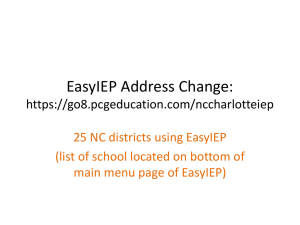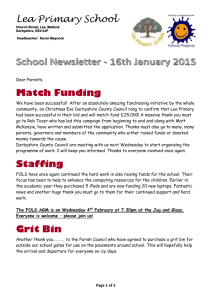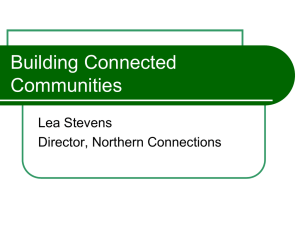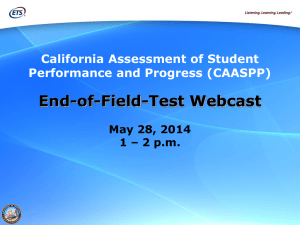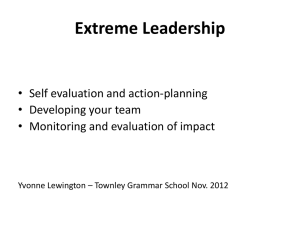MOU Worksheet - Center for Development and Disability
advertisement
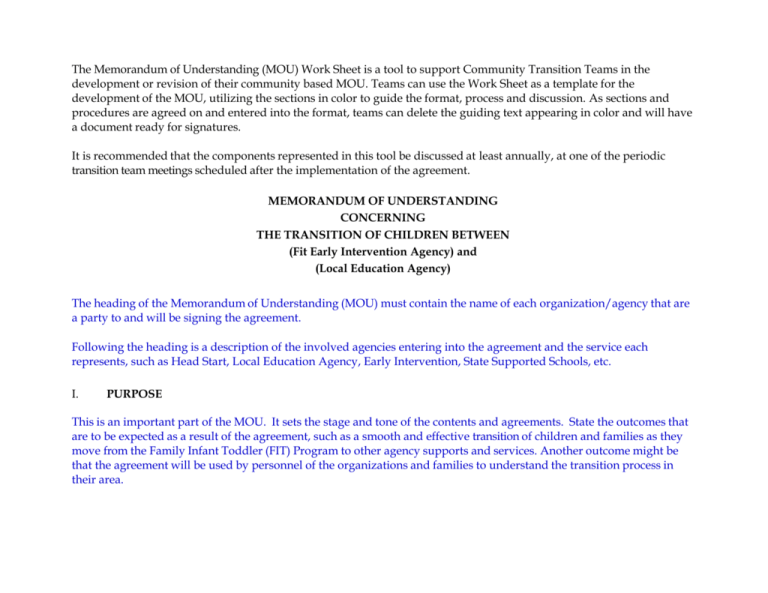
The Memorandum of Understanding (MOU) Work Sheet is a tool to support Community Transition Teams in the development or revision of their community based MOU. Teams can use the Work Sheet as a template for the development of the MOU, utilizing the sections in color to guide the format, process and discussion. As sections and procedures are agreed on and entered into the format, teams can delete the guiding text appearing in color and will have a document ready for signatures. It is recommended that the components represented in this tool be discussed at least annually, at one of the periodic transition team meetings scheduled after the implementation of the agreement. MEMORANDUM OF UNDERSTANDING CONCERNING THE TRANSITION OF CHILDREN BETWEEN (Fit Early Intervention Agency) and (Local Education Agency) The heading of the Memorandum of Understanding (MOU) must contain the name of each organization/agency that are a party to and will be signing the agreement. Following the heading is a description of the involved agencies entering into the agreement and the service each represents, such as Head Start, Local Education Agency, Early Intervention, State Supported Schools, etc. I. PURPOSE This is an important part of the MOU. It sets the stage and tone of the contents and agreements. State the outcomes that are to be expected as a result of the agreement, such as a smooth and effective transition of children and families as they move from the Family Infant Toddler (FIT) Program to other agency supports and services. Another outcome might be that the agreement will be used by personnel of the organizations and families to understand the transition process in their area. II. REQUIREMENTS IMPACTING THIS AGREEMENT List Federal and/or State transition laws by using the title of the law and numbers, if applicable. Also, list any agency transition requirements. There might also be Program Operations Guidelines that pertain to transition. III. DEFINITION OF TERMS Provide definitions of terms that will be used throughout the agreement in order to support clear communication with all parties. Terms to define include IEP, IFSP, Sending Agency, Receiving Agency, etc. IV. IMPLEMENTATION OF AGREEMENT How will copies of the agreement be provided to those who will use it in the transition process? When and how will families, the appropriate staff of the agencies involved, and independent providers be informed and trained on the contents of the agreement. V. MONITORING AND EVALUATION OF THE AGREEMENT State who will make sure the agreement is working. When and how will the effectiveness be evaluated? State how changes will be made to the agreement based on the findings of this monitoring and evaluation. What criteria will you use to evaluate that the agreement is a valid, functioning part of the transition system? VI. INTERAGENCY DISPUTE PROCESS State the details of how disputes/conflicts between the agencies signing this agreement will be resolved. What is the timeline for resolution? VII. DURATION State the specific beginning and ending dates of this agreement such as April 1, 2012 through March 31, 2013. When will the review take place to update the agreement? VII. WORKING PROCEDURES, TIMELINES AND RESPONSIBILITIES IN TRANSITION PROCESS Describe what, when, where, how and who is responsible for the various steps in the transition process in order to have a successful transition from one program to another. NOTIFICATION Data on potentially eligible children sent to LEA. Local level data shared NMAC 7.30.8.13 TRANSITION (B) (1) 7.30.8.13 TRANSITION (B)(1) The FIT program shall provide notification to the public education department, special education bureau, of all potentially eligible children statewide who will be turning three years old in the following twelve month period. (2) The early intervention provider agency shall notify the LEA of all potentially eligible children residing in their district who will turn three years old in the following twelve month period. This will allow the LEA to conduct effective program planning. (3) The notification from the early intervention provider agency to the LEA shall: (a) include children who are potentially eligible for preschool special education services under the Individuals with Disabilities Education Act (IDEA) Part B; potentially eligible children are those children who are eligible under the developmental delay or established condition categories; (b) include the child’s name, date of birth, and contact information for the parent(s); (c) be provided at least quarterly in accordance with the process determined in the local transition agreement; and (d) be provided not fewer than 90 days before the third birthday of each child who is potentially eligible for IDEA Part B. NMAC 6.31.2.11 (A) (5) (a) Each LEA shall survey Part C programs within its educational jurisdiction in its child find efforts to identify children who will be eligible to enter the LEA’s Part B preschool program in future years. Questions To Consider How will FIT Provider(s) notify the LEA(s) of children they are currently serving who may be potentially eligible for Part B services and are approaching the age of eligibility? Who in the FIT Provider agency will be responsible for the notification? Who in the LEA will be responsible for receiving and documenting the information? When specifically in quarter will the information be shared? (month/day) How will the information be shared and how often? (mail, email, fax, etc.) What will happen when children enter early intervention late and are approaching the age of eligibility? FIT PROVIDER LEA HEAD START OTHER TRANSITION PLANNING Individualized steps and services added to IFSP NMAC 7.30.8.13 (C) (1) A transition plan shall be developed with the parent(s) for each eligible child and family that addresses supports and services after the child leaves the FIT program. (2) The transition plan shall be included as part of the child’s IFSP and shall be updated, revised and added as needed. (3) The following is the timeline for developing the transition plan: (a) at the child’s initial IFSP meeting, the transition plan shall be initiated and shall include documentation that the family service coordinator has informed the parent(s) regarding the timelines for their child’s transition; (b) by the time child is 24 months old, the transition plan will be updated to include documentation that the family service coordinator has informed the parent(s) of the early childhood transition options for their child and any plans to visit those settings; and (c) at least 90 days, and not more than nine months before the child’s third birthday, the transition plan shall be finalized at an annual IFSP or transition conference meeting that meets the attendance requirements of this rule. 6.31.2.11(A)(4) Each public agency shall develop and implement appropriate policies and procedures to ensure a smooth and effective transition from Part C to Part B programs for preschool children with disabilities within the agency’s educational jurisdiction, in compliance with 34 CFR Sec. 300.124. Each LEA and other public agencies as appropriate shall make reasonable efforts to establish productive working relations with local Part C programs and when given reasonable notice shall participate in the transition planning conferences arranged by local Part C providers. 6.31.2.11(A)(5) (b) Each LEA shall promote parent and family involvement in transition planning with Part C programs, community programs and related services providers at least six months before the child is eligible to enter the LEA’s Part B preschool program. (c) Each LEA shall establish and implement procedures to support successful transitions including parent training, professional development for special educators and general educators, and student and parent self-advocacy training and education. (d) Each LEA shall assist parents in becoming their child’s advocates as the child makes the transition through systems. Questions To Consider How will the FIT Family Service Coordinator support families in understanding the transition process, program options, and services provided by the LEA and other programs such as Head Start? How will LEA coordinate with FIT providers and other programs to facilitate visits by families to classrooms and/or learn about services provided? Are there other ways the LEA and other programs support transition planning (available for questions, family nights, brochures, participation opportunities, etc.)? FIT PROVIDER LEA HEAD START OTHER REFERRAL TO LEA Referral form sent to LEA with parent consent 7.30.8.13 D (1) A transition referral shall be submitted by the family service coordinator with parental consent, to the LEA at least 60 days prior to the transition conference. The transition referral shall include at a minimum the child’s name, the child’s date of birth, the child’s address of residence, and the contact information for the parent(s) including name(s), address (es), and phone number(s). 7.30.8.13 D (2) For children who enter the FIT program less than 90 days before their third birthday, the family service coordinator shall submit a referral, with parental consent, as soon as possible to the LEA. This referral shall serve as the notification for the child. No further notification to the LEA shall be required for the child. (3) For children referred to the FIT program less than 45 days before the child’s third birthday, the family service coordinator shall submit a referral to the LEA, with parental consent, but the early intervention provider agency will not conduct an evaluation to determine eligibility in accordance with the referral and intake provisions of this rule. 7.30.8.7 K “Consent” means informed written prior authorization by the parent(s) to participate in the early intervention system. The parent has been fully informed of all information relevant to the activity for which consent is sought in the parent’s native language and mode(s) of communication and agrees to the activity for which consent is sought. The parent(s) shall be informed that the granting of consent is voluntary and can be revoked at any time. The revocation of consent is not retroactive. Questions To Consider Who from the FIT program will get parent consent and send the Transition Referral Form to the LEA? How will the referral be sent (mail, email, fax, etc.)? When will the referral be sent to the LEA? (At least 60 days prior to conference and if possible 6 months prior to 3rd birthday). Who from the LEA will confirm and document receipt of referral? How will late referrals to FIT be handled by both FIT and the LEA? How will late referrals be addressed over the summer? FIT PROVIDER LEA HEAD START OTHER PRE-PLANNING FOR TRANSITION CONFERENCE Coordinate among parents, FIT, LEA on conference date. Provide written invitation to Transition Conference to LEA and all parties. Send Transition Assessment Summary Form to LEA. LEA reviews materials and determines who will attend. 7.30.8.13 E. Invitation to the transition conference: The family service coordinator shall submit an invitation to the Transition Conference to the LEA and other preschool programs at least 30 days prior to the Transition Conference. 7.30.8.13 F. Transition assessment summary: (1) The family service coordinator shall submit a completed transition assessment summary form to the LEA at least 30 days prior to the Transition Conference. (2) Assessment results, including present levels of development, must be current within six months of the Transition Conference. 7.30.8.13 G. Transition Conference: The Transition Conference shall: (1) be held with the approval of the parent(s); (2) be held at least 90 days and no more than nine months prior to the child’s third birthday; (3) meet the IFSP meeting attendance requirements of this rule; (4) take place in a setting and at a time that is convenient to the family; (5) be conducted in the native language of the family, or other mode of communication used by the family, unless it is clearly not feasible to do so; (6) with permission of the parent(s), include other early childhood providers (early head start/Head Start, child care, private preschools, New Mexico School for the Deaf, New Mexico School for the Blind and Visually Impaired, etc.). 6.31.2.11 A. (3) (b) The Part B eligibility determination team shall review current assessments and shall determine the additional data and assessments needed for the comprehensive evaluation. Current assessments are defined as assessments, other than medical assessments, conducted no more than six months prior to the date of the meeting of the Part B eligibility determination team. 6.31.2.11.A (4) Each public agency shall develop and implement appropriate policies and procedures to ensure a smooth and effective transition from Part C to Part B programs for preschool children with disabilities within the agency’s educational jurisdiction, in compliance with 34 CFR Sec. 300.124. Each LEA and other public agencies, as appropriate, shall make reasonable efforts to establish productive working relations with local Part C programs and, when given reasonable notice, shall participate in the transition planning conferences arranged by local Part C providers. Questions To Consider How will scheduling of the Transition Conference be coordinated? How will information and communication take place between all parties involved? Who will be writing and sending the written invitations to the Transition Conference? When will the written invitations be sent? Who at the LEA will receive the invitation? How will other relevant potential providers (NMSD, NMSBVI, Head Start, etc.) be included? What pertinent information and attachments are needed on the Assessment Summary Form? What information will FIT make available on the Assessment Summary Form to support determination of the child’s educational needs? When will the Assessment Summary Form be sent and how (hand delivered, mailed, etc.) Who at LEA will receive the Assessment Summary Form and document receipt? How will the LEA review the information and plan for the Transition Conference? What will be the procedures for children who turn three over the summer? FIT PROVIDER LEA HEAD START OTHER TRANSITION CONFERENCE Explain Part B and C procedures and safeguards. Provide prior written notice. Review if all current evaluations and/or assessments have been given to the LEA. Obtain consent for evaluation. Complete IFSP Transition Conference page; discuss program options and next steps with LEA 7.30.8.13 (G) (7) Transition conference: The transition conference shall be facilitated by the family service coordinator to include: (a) a review of the parent(s)’s preschool and other service options for their child; (b) a review of and, if needed, a finalization of the transition plan; (c) a review of the current IFSP, the assessment summary and any other relevant information; (d) the transmittal of the IFSP, evaluation and assessments and other pertinent information with parental consent; (e) an explanation by an LEA representative of the IDEA Part B procedural safeguards and the eligibility determination process, including consent for the evaluation; (f) as appropriate, discussion of communication considerations (if the child is deaf or hard of hearing) and Braille determination (if the child has a diagnosis of a visual impairment), autism considerations, and considerations for children for whom English is not their primary language. (g) discussion of issues, including enrollment of the child, transportation, dietary needs, medication needs, etc. (h) documentation of the decisions made on the transition page and signatures on the Transition Conference signature page, which shall be included as part of the IFSP. Copies of the Transition Conference page and signature page shall be sent to all participants. 6.31.2.11 (A) (5)(e) Each LEA shall participate in transition planning conferences arranged by the designated Part C lead agency no less than 90 days prior to the anticipated transition or the child’s third birthday, whichever occurs first, to facilitate informed choices for all families. Questions To Consider How will the Family Service Coordinator conduct the meeting (agenda, time frame, etc.)? Who from the LEA will participate in the Transition Conference? What forms and information will be shared? How and when will LEA obtain parental consent to conduct initial evaluation? How and when will LEA schedule a date for qualified professionals and parents to review existing data as part of the process for determining eligibility? How and when will LEA schedule further evaluation activities if needed? What happens if parent is not ready to proceed with eligibility determination during the conference? What happens if any party is unable to attend the Transition Conference? FIT PROVIDER LEA HEAD START OTHER INITIAL COMPREHENSIVE EVALUATION FOR PART B Part B team reviews current available assessment data (including Part C assessments) Part B team determines additional data and assessments needed. Part B team conducts initial comprehensive evaluation process in all areas of suspected disability 6.31.2.10 E. Procedural requirements for the assessment and evaluation of culturally and linguistically diverse children. 1. Each public agency must ensure that tests and other evaluation materials used to assess children are selected, provided and administered so as not to be discriminatory on a racial or cultural basis and are provided and administered in the child’s native language or other mode of communication, such as American sign language, and in the form most likely to yield accurate information on what the child knows and can do academically, developmentally and functionally, unless it is clearly not feasible to select, provide or administer pursuant to 34 CFR Sec. 300.304(c)(1). 2. Each public agency must ensure that selected assessments and measures are valid and reliable and are administered in accordance with instructions provided by the assessment producer and are administered by trained and knowledgeable personnel. 3. Each public agency must consider information about a child’s language proficiency in determining how to conduct the evaluation of the child to prevent misidentification. A child may not be determined to be a child with a disability if the determinant factor for that eligibility determination is limited English proficiency. Comparing academic achievement results with grade level peers in the public agency with similar cultural and linguistic backgrounds should guide this determination process and ensure that the child is exhibiting the characteristics of a disability and not merely language difference in accordance with 34 CFR Sec. 300.306(b)(1). 4. Each public agency must ensure that the child is assessed in all areas related to the suspected disability. 5. Policies for public agency selection of assessment instruments include: (a) assessment and evaluation materials that are tailored to assess specific areas of educational need; and (b) assessments that are selected ensure that results accurately reflect the child’s aptitude or achievement level. 6. Public agencies in New Mexico shall devote particular attention to the foregoing requirements in light of the state’s cultural and linguistic diversity. Persons assessing culturally or linguistically diverse children shall consult appropriate professional standards to ensure that their evaluations are not discriminatory and should include appropriate references to such standards and concerns in their written reports. 6.31.2.11 (A) (3) To ensure effective transitioning from IDEA Part C programs to IDEA Part B programs, each public agency must conduct a full and individual initial comprehensive evaluation at no cost to the parent and in compliance with requirements of 34 CFR Secs. 300.300, 300.301, 300.302, 300.304 and 300.305 and other department rules and standards before the initial provision of Part B special education and related services to a child with a disability. (a) The initial comprehensive evaluation process shall be conducted in all areas of suspected disability. Questions To Consider Who from the LEA is responsible for conducting the initial comprehensive evaluation in all areas of suspected disability? How will a group of qualified professionals from the LEA review existing information provided by FIT? How will the LEA evaluation team use FIT information in supporting Part B eligibility determination? How will the parent have input? If additional data and assessment are needed, how will the LEA coordinate activities? If needed, how will NMSBVI and NMSD be involved? What is FITs role in the process? When and where is the eligibility determination meeting held? FIT PROVIDER LEA HEAD START OTHER ELIGIBILITY DETERMINATION MEETING 6.31.2.11(A)(5)(f) Each LEA shall designate a team, including parents and qualified professionals, to review existing evaluation data for each child entering the LEA’s preschool program in compliance with 34 CFR Sec. 300.305 and, based on that review, identify what additional data, if any, are needed to determine the child’s eligibility for Part B services or develop an appropriate program. 6.31.2.10 F. Eligibility determinations. (1) General rules regarding eligibility determinations (a) Upon completing the administration of tests and other evaluation materials, a group of qualified professionals and the parent of the child must determine whether the child is a child with a disability, as defined in 34 CFR Sec. 300.8 and Paragraph (2) of Subsection B of 6.31.2.7 NMAC. The determination shall be made in compliance with all applicable requirements of 34 CFR Sec. 300.306. (b) The public agency must provide a copy of the evaluation report and the documentation of determination of eligibility to the parent. 6.31.2.7(B)(2) “Child with a disability” means a child who meets all requirements of 34 CFR Sec. 300.8 and who: (a) is aged 3 through 21 or will turn 3 at any time during the school year; (b) has been evaluated in accordance with 34 CFR Secs. 300.304-300.311 and any additional requirements of these or other public education department rules and standards and as having one or more of the disabilities specified in 34 CFR Sec. 300.8 including intellectual disability; a hearing impairment including deafness; a speech or language impairment; a visual impairment including blindness; emotional disturbance; orthopedic impairment; autism; traumatic brain injury and other health impairment; a specific learning disability; deaf-blindness; or being developmentally delayed as defined in 6.31.2.7(B)(4) NMAC and who has not received a high school diploma; and (c) at the discretion of each local educational agency and subject to the additional requirements of Subsection 2 of Paragraph F of 6.31.2.10 NMAC, the term “child with a disability” may include a child aged 3 through 9 who is evaluated as being developmentally delayed and who, because of that condition, needs special education and related services. (6.31.2.7(B) (19) NMAC as authorized by 34 CFR §§ 300.8 and 300.39, “special education” in New Mexico may include speech-language pathology services.) Questions to Consider How will the LEA meet to determine eligibility? How will the parents be involved in the process? How will FIT be involved in the process? How will state supported schools or other partners be involved in the process? FIT PROVIDER LEA HEAD START OTHER EVALUATION REPORT AND DOCUMENTATION OF ELIGIBILITY SENT TO PARENT 6.31.2.10 F. Eligibility determinations. (1) General rules regarding eligibility determinations (a) Upon completing the administration of tests and other evaluation materials, a group of qualified professionals and the parent of the child must determine whether the child is a child with a disability, as defined in 34 CFR Sec. 300.8 and Paragraph (2) of Subsection B of 6.31.2.7 NMAC. The determination shall be made in compliance with all applicable requirements of 34 CFR Sec. 300.306. (b) The public agency must provide a copy of the evaluation report and the documentation of determination of eligibility to the parent. Questions to Consider Who sends and who are the recipients of the Evaluation Report and documentation? If FIT and state supported school providers are to receive a copy of the report from the LEA, when will parent consent to release it to them be obtained (at the Transition Conference, at the Eligibility Determination Meeting, etc.)? How will FIT providers verify if the child was made eligible for Part B? FIT PROVIDER LEA HEAD START OTHER INDIVIDUALIZED EDUCATION PROGRAM (IEP) DEVELOPED 6.31.2.11 A (5) (g) Development of IFSP, IEP or IFSP-IEP. (i) The IFSP, IEP, or IFSP-IEP will be developed by a team constituted in compliance with 34 CFR Sec. 300.321 that includes the parents. For children transitioning from Part C programs to Part B programs, the team must also include one or more early intervention providers who are knowledgeable about the child. “Early intervention providers” are defined as Part C service coordinators or other representatives of the Part C system. 7.30.8.13 I (1) The family service coordinator and other early intervention personnel shall participate in a meeting to develop the IEP (or IFSP-IEP) with parent approval. (2) the family service coordinator, with parent consent, shall provide any new or updated documents to the LEA in order to develop the IEP. Questions to Consider Who from the LEA is responsible for developing the IEP? How and when will the LEA inform the parents of their right to invite other representatives (FIT, Head Start, etc.) to the IEP meeting? If needed, how will NMSBVI and NMSD be involved? How and when will FIT and others be invited to the IEP meeting with parental consent? When invited, how will FIT coordinate participation of appropriate early intervention staff in the IEP meeting? What is the process for children whose third birthday occurs during the summer? FIT PROVIDER LEA HEAD START OTHER IN WITNESS WHEREOF, the following signatures are affixed: SIGNATURES/DATES Make sure that all the parties to the agreement sign and date it. All the parties listed in the heading of the agreement must sign. Without a signature to the agreement, the agency is not accountable. Assure that a person in authority from the agency is signing the agreement. The agreement can be signed at a meeting with the agencies involved. _______________________________________________________________ Name of Person Signing, Title Agency Name _______________________________________________________________ Name of Person Signing, Title Agency Name _______________________________________________________________ Name of Person Signing, Title Agency Name _______________________________________________________________ Name of Person Signing, Title Agency Name ___________________ Date ___________________ Date ___________________ Date ___________________ Date

